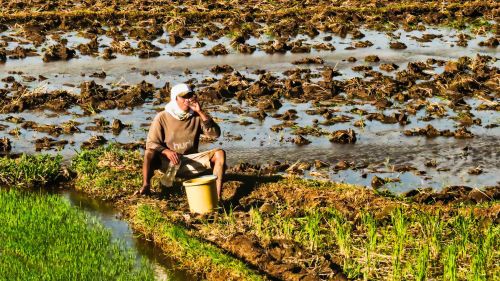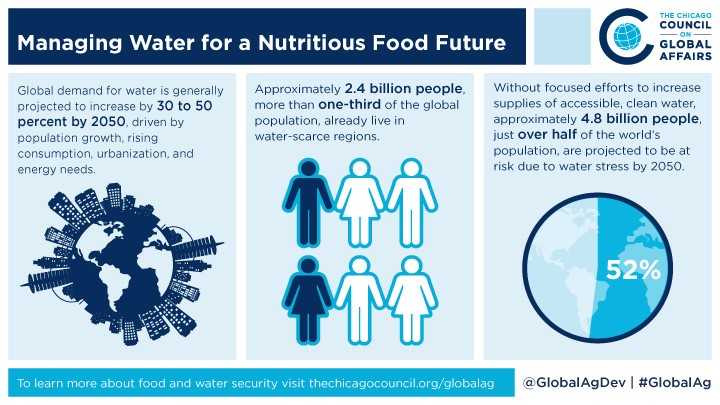Achieving Food and Nutrition Security in the Face of Water Scarcity

Failure to treat water as a strategic, valuable, and limited resource is a direct threat to the global economy; the health of our planet; and the well-being of both current and future generations of humanity.
Introduction
The world is running out of water to feed—and nourish—a rapidly growing global population. Freshwater availability is already strained, and increasing water scarcity, degradation of ecosystems, and water quality constraints present major challenges for future food and nutrition security. Nearly all human activity requires access to clean water; at the most basic level, every one of us is implicated in water consumption by virtue of the food and water we need to survive.
Failure to treat water as a strategic, valuable, and limited resource is a direct threat to the global economy; the health of our planet; and the well-being of both current and future generations of humanity. One of the greatest challenges of our time is how to advance a more sustainable, resilient, and inclusive global food system in the face of this increasing water scarcity.
Competition for Water is Intensifying
Water touches every aspect of our lives: food, health, environment, industry, and leisure. By 2050, the global population is expected to increase to 9.8 billion, with 86 percent living in low- to middle-income countries and 70 percent in rapidly growing urban areas. In that same time frame, global demand for water is generally projected to increase by 30 to 50 percent, driven by population growth, rising consumption, urbanization, and energy needs. How do we protect this essential and shared resource, while nourishing a growing global population?

The competition for water resources is intensifying between cities and rural areas, risking the prosperity of both. Climate change further threatens water, food, and nutrition security, as greater variability in precipitation and increases in temperature disrupt agricultural production. In the extreme case of Cape Town, residents faced the worst drought on record and the subsequent threat of “Day Zero,” when the city expected that it would be forced to shut off taps to homes and businesses because water resources were perilously low. While Cape Town managed to evade this doomsday scenario—for the time being—it serves as a somber warning for water-stressed regions around the world of how overdevelopment, population growth, and climate change can upset the balance between water use and supply.
Smallholder farmers, who often reside in regions with the least resources to adapt, are at the greatest risk of total crop failure due to increased climate variability. Scaling up irrigation can help these farmers build resilience, protect against variable rainfall patterns, and increase productivity: while only 20 percent of all cultivated land is irrigated, this land accounts for about 40 percent of agricultural production. But irrigation has costs if poorly managed, including groundwater depletion and soil degradation. Expanding access to irrigation must be approached carefully to avoid overuse and increased vulnerability.
Adding to this pressure, rising incomes and urbanization lead to increased demand for diverse, nutritious diets—including fruits, vegetables, legumes, nuts, healthy oils, and animal source foods—which require more predictable supplies of water to produce. Trends around what constitutes a ‘healthy’ diet from a sustainable food system are emerging in wealthy economies, with proposals such as the planetary health diet being brought to the forefront of consumer awareness. Weighing the health, environmental, economic, and social implications of diets to optimize outcomes for each is no easy task and shifting dietary patterns can be complicated and contentious. Also, converting production and livelihood reliance for smallholder farmers, many of whom live on less than two dollars a day and have little room for experimentation, presents an added challenge.
Turning Challenges in the Agri-Food System into Opportunities
Agriculture depends on a reliable source of water and it is expected to remain the largest user of fresh water resources in all regions in the foreseeable future: the fresh water required to produce crops and livestock accounts for the largest percentage (over 70 percent) of water usage among all sectors.
In order to advance food and nutrition security, efforts to improve agricultural productivity and development must be combined with leadership and initiatives around effective water use and management in agri-food systems. With the right policies, incentives, and support, smallholder farmers can play an important role in simultaneously increasing water productivity and securing food and nutrition security for generations to come. With their proximity to growing markets and relative competitiveness, these farmers are well-positioned to produce the high-value crops needed to meet consumer demand and lift themselves and their communities out of poverty.
Even the greatest challenges in the agri-food system can be overcome through collaboration and innovation. The nexus between food, water, and energy shows how changes in one sector have an impact on one or both of the other sectors; the more we can understand these linkages, the better positioned we are to encourage the development of collective solutions to shared challenges. For example, integrating policies and building collaboration across the water, sanitation, and hygiene (WASH) sector and the agri-food sector could offer vital new pathways for health and nutrition.
Several existing strategies can be used to address the challenge posed by increasing water scarcity, such as improving crop and livestock productivity and increasing the supply of managed water through investment in infrastructure. In addition, emerging solutions, such as increasing urban and peri-urban agriculture and virtual water trade, hold potential for future development. Finally, the agri-food sector is ripe for disruptive innovations in terms of technologies, policies, and business models. For example, a team of Global Knowledge Initiative researchers recently conducted a scan for innovations across global food systems, focusing specifically on the need to reduce post-harvest loss. New technologies and innovations, as well as transformative new policies, must be embraced if we are to create a world of consistent and lasting abundance.
The Way Forward
Finding solutions to provide nutritious food to nearly 10 billion people by 2050 while protecting our planet is one of the most important leadership opportunities of the 21st Century. Water impacts all of us, and the transformation required to achieve a global food system we want (and need) will require changes on multiple levels—process, product, organizational, and market-based—led by multiple stakeholders—farmers, scientists, advocates, private sector leaders, and, policy-makers. In order to protect this essential and shared resource, we must implement collaborative, proactive approaches to improve water quality, reduce water scarcity, and create a more sustainable and resilient global food system. The future health and well-being of our people and planet depend on it.
"Unchartered Waters" Series
- Farmer-Led Irrigation for Agricultural Intensification
- Achieving Food and Nutrition Security in the Face of Water Scarcity
- Growing Cities, Changing Diets
- The Livestock Ladder’s Water Footprint
- Are the Sustainable Development Goals for Water and Food Working Against One An…
- From Chicago to Uganda, Clean Water is Key to Good Nutrition
- The Gendered Burden of Water